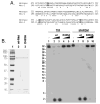Biochemical characterization of a SET and transposase fusion protein, Metnase: its DNA binding and DNA cleavage activity
- PMID: 17877369
- PMCID: PMC3374406
- DOI: 10.1021/bi7005477
Biochemical characterization of a SET and transposase fusion protein, Metnase: its DNA binding and DNA cleavage activity
Abstract
Metnase (SETMAR) is a SET and transposase fusion protein that promotes in vivo end joining activity and mediates genomic integration of foreign DNA. Recent studies showed that Metnase retained most of the transposase activities, including 5'-terminal inverted repeat (TIR)-specific binding and assembly of a paired end complex, and cleavage of the 5'-end of the TIR element. Here we show that R432 within the helix-turn-helix motif is critical for sequence-specific recognition, as the R432A mutation abolishes its TIR-specific DNA binding activity. Metnase possesses a unique DNA nicking and/or endonuclease activity that mediates cleavage of duplex DNA in the absence of the TIR sequence. While the HTH motif is essential for the Metnase-TIR interaction, it is not required for its DNA cleavage activity. The DDE-like motif is crucial for its DNA cleavage action as a point mutation at this motif (D483A) abolished its DNA cleavage activity. Together, our results suggest that Metnase's DNA cleavage activity, unlike those of other eukaryotic transposases, is not coupled to its sequence-specific DNA binding.
Figures








Similar articles
-
Metnase/SETMAR: a domesticated primate transposase that enhances DNA repair, replication, and decatenation.Genetica. 2010 May;138(5):559-66. doi: 10.1007/s10709-010-9452-1. Epub 2010 Mar 23. Genetica. 2010. PMID: 20309721 Free PMC article. Review.
-
Crystal structure of the human Hsmar1-derived transposase domain in the DNA repair enzyme Metnase.Biochemistry. 2010 Jul 13;49(27):5705-13. doi: 10.1021/bi100171x. Biochemistry. 2010. PMID: 20521842
-
Regulation of Metnase's TIR binding activity by its binding partner, Pso4.Arch Biochem Biophys. 2010 Jun 15;498(2):89-94. doi: 10.1016/j.abb.2010.04.011. Epub 2010 Apr 20. Arch Biochem Biophys. 2010. PMID: 20416268 Free PMC article.
-
Biochemical characterization of metnase's endonuclease activity and its role in NHEJ repair.Biochemistry. 2011 May 24;50(20):4360-70. doi: 10.1021/bi200333k. Epub 2011 Apr 27. Biochemistry. 2011. PMID: 21491884 Free PMC article.
-
Assembly of the Tc1 and mariner transposition initiation complexes depends on the origins of their transposase DNA binding domains.Genetica. 2007 Jun;130(2):105-20. doi: 10.1007/s10709-006-0025-2. Epub 2006 Aug 16. Genetica. 2007. PMID: 16912840 Review.
Cited by
-
Metnase/SETMAR: a domesticated primate transposase that enhances DNA repair, replication, and decatenation.Genetica. 2010 May;138(5):559-66. doi: 10.1007/s10709-010-9452-1. Epub 2010 Mar 23. Genetica. 2010. PMID: 20309721 Free PMC article. Review.
-
Metnase and EEPD1: DNA Repair Functions and Potential Targets in Cancer Therapy.Front Oncol. 2022 Jan 28;12:808757. doi: 10.3389/fonc.2022.808757. eCollection 2022. Front Oncol. 2022. PMID: 35155245 Free PMC article. Review.
-
The SET Domain Is Essential for Metnase Functions in Replication Restart and the 5' End of SS-Overhang Cleavage.PLoS One. 2015 Oct 5;10(10):e0139418. doi: 10.1371/journal.pone.0139418. eCollection 2015. PLoS One. 2015. PMID: 26437079 Free PMC article.
-
Molecular impact of selective NFKB1 and NFKB2 signaling on DLBCL phenotype.Oncogene. 2017 Jul 20;36(29):4224-4232. doi: 10.1038/onc.2017.90. Epub 2017 Apr 3. Oncogene. 2017. PMID: 28368397
-
Mechanisms of leukemia translocations.Curr Opin Hematol. 2008 Jul;15(4):338-45. doi: 10.1097/MOH.0b013e328302f711. Curr Opin Hematol. 2008. PMID: 18536572 Free PMC article.
References
Publication types
MeSH terms
Substances
Grants and funding
LinkOut - more resources
Full Text Sources
Molecular Biology Databases

